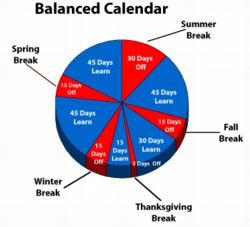Pros and Cons of Year Round School: Is Year-Round Education The Way Forward?
Have you heard the talk of year round education? The long summer break may fill every child with excitement – days full of fun and no commitments, time to spend with friends without the stress of school. For most parents, the summer brings the challenge of finding ways to entertain their children. Sure, there is the allure of a family vacation, but for many parents, juggling work, children and finances is no easy task. Year-round schooling is becoming more popular in many areas and is something the rest of the world has been doing for years. It certainly addresses a lot of the issues that parents face, but does it really mean better education for our children? Read on to find out the pros and cons of year-round schooling.
To understand the various benefits and drawbacks of a year-round schooling system, this article will delve into a number of factors favored by both advocates and critics to help create an objective view. Every child and family is unique, so a one-size-fits-all model shouldn’t apply. Having the option to send your child to a year-round school adds another opportunity to consider and provides parents with more chances to give their children the best education possible.

Does a Year-Round School Mean More Days at School?
 First and foremost, the idea that year-round schooling means more days at school is simply not true. The model still operates on the basic system of 180 days classroom time, it is just allocated in a different way.
First and foremost, the idea that year-round schooling means more days at school is simply not true. The model still operates on the basic system of 180 days classroom time, it is just allocated in a different way.
So if children aren’t spending any more time in the classroom, how does year-round schooling have a positive impact on children’s learning? Let’s look at the system in greater detail. Most year-round schools operate on a 45-15 day plan. This means that students attend school for 45 days, or nine weeks, and then have a three week break at the end of that time period. Other common timelines include a 60-20 and a 90-30 plan.
No matter which way you slice it, the holiday periods are more evenly spread throughout the year and the time spent at school remains the same, just in smaller chunks of time.
The Effect of Summer Brain Drain
 While a lengthy summer vacation will certainly help to reinvigorate both students and teachers, it can be detrimental to a quality education.
While a lengthy summer vacation will certainly help to reinvigorate both students and teachers, it can be detrimental to a quality education.
Children who don’t participate in activities that stimulate them over the summertime break will find that come the start of school in September, their brain function has depleted somewhat. Those from disadvantaged backgrounds, as well as children who speak English as a second language are the ones that would benefit most from more continuous learning.
Those students that are able to take part in camps, activities, travel and all the other opportunities that are available for young people are going to remain stimulated, interested and learning. Their minds will remain active and they will have less brain drain or learning loss over the summer.
Participating in a year round school program that has shorter but more frequent breaks will lessen the impact of being out of school. There’s simply less time to lose the gains that were made during the semester prior according to those in favor of this type of program.
Overcrowding and Multi-functional Buildings
Schools are not cheap to build, so it seems like a waste to have the buildings empty for almost a quarter of the year. Even in a year-round model, the amount of time the building is in use does remain the same. The argument here comes from some school districts who have implemented the year-round model on a rotational system to help alleviate the problem of overcrowding. This is called the multi-track system.
A multi-track system effectively divides students into groups, each operating on their own calendar, meaning that the school buildings are in use all year round. Sure, there would be an increase in running costs of the school but it is certainly a cheaper way to cater for a growing number of students than it would be by building an entirely new school.
A big problem here is for parents who may have children with different school calendars struggling to arrange childcare, not to mention the impossibility of a whole family vacation!
Summer Opportunities
For older children, a long summer break gives them the opportunity to take on a summer job and learn the value of hard work, commitment, and how to manage their personal finances.
With shorter breaks, these opportunities may not present themselves as frequently or as easily. In the year round model, students would likely have to take different jobs that would run year round or seasonally while still going to school.
Working Out Family Logistics
Many parents already have a tough time balancing work and their children’s education. Arrangements for morning drop-off and afternoon pick-up need to be made, after school activities arranged and vacation programs booked. So, you can only imagine how much trickier this would be if different schools, even those within the same district, worked under different systems. Parents could potentially find themselves in a literal logistical nightmare!
How Do Teachers Cope?
We all know teaching is a stressful job. Teachers work far more hours than those of the school day, spending their evenings, weekends, and holidays planning and reviewing and grading. Teacher burnout is a real problem, with about 8% of the profession leaving each year.
This is one are that may be reduced if schools offer more frequent breaks for not only their students but their faculty and staff as well. Sure, teachers will spend a lot of their vacation time doing work, but the time away from the classroom is often enough to sufficiently recharge the batteries and would enable more qualified, experienced staff to stay in the industry.
What About the Rest of the World?
Most other countries do not offer students such a lengthy summer break as we see here in the US and they seem to manage just fine. In fact, many of these countries are ranked higher than the US in their educational capabilities and ratings. Students are still rewarded with breaks, and quite decent ones, and the number of days spent at school doesn’t differ greatly.
An interesting point to note is that students in the US generally have longer school days than many other countries and also start formal schooling much younger, however, the results in how students are doing compared to other countries for all this extra education isn’t showing.
One example of this, Finland is well-renowned for its successful educational system. Children in Finland start school around age six or seven and attend classes for roughly four hours each day. Of course, Finland and the United States are two very different countries so comparing them is hard, but it certainly gives some food for thought as to how much schooling children need in order to be successful.
Conclusion
Despite all of this, shouldn’t the focus be on quality not quantity? Does year-round schooling make for a more productive and effective education? Perhaps it does. But a long summer break may also lead to further opportunities for many children. Bottom line – give your child the best education you possibly can, whatever this may be. Let us know your thoughts and comments in the comment section below! This is definitely a topic that most of us have an opinion on.

Enjoy All The Benefits
You don’t pay your first hour unless you find it a good fit.
Only pay for the time you need.
No subscriptions or upfront payments.
Find Tutors Near You
